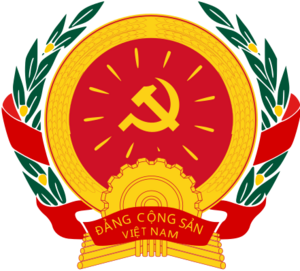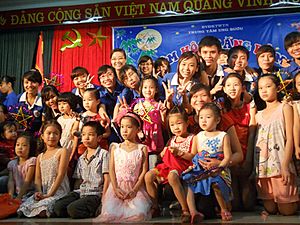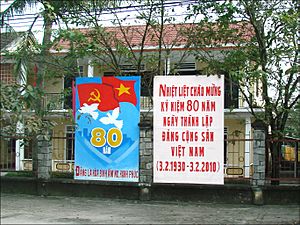Communist Party of Vietnam facts for kids
Quick facts for kids
Communist Party of Vietnam
Đảng Cộng sản Việt Nam
|
|
|---|---|
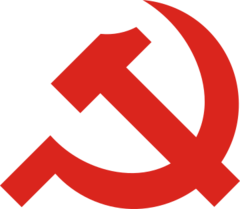 |
|
| Abbreviation | CPV ĐCS / ĐCSVN |
| Governing body | Central Committee |
| General Secretary | Tô Lâm |
| Executive Secretary | Trần Cẩm Tú |
| Founder | Ho Chi Minh |
| Founded | 3 February 1930 |
| Merger of |
|
| Split from | Indochinese Communist Party (1945) |
| Headquarters | 1A, Hùng Vương Street, Ba Đình, Hanoi |
| Newspaper | Nhân Dân |
| Student wing | Vietnam National Union of Students |
| Youth wing | Ho Chi Minh Communist Youth Union |
| Women's wing | Vietnam Women's Union |
| Pioneer organization | Ho Chi Minh Young Pioneer Organization |
| Armed wing | Vietnam People's Armed Forces |
| Research office | Central Theoretical Council |
| Membership (2021) | 5,300,000 |
| Ideology |
|
| National affiliation | Vietnamese Fatherland Front |
| International affiliation | IMCWP |
| Colors | Red |
| Anthem | "The Internationale" () |
| National Assembly |
465 / 500
|
| Party flag | |
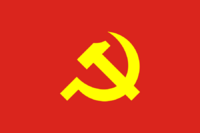 |
|
| Website | |
| (vi-VN) (en-US) |
|
The Communist Party of Vietnam (CPV) is the main political party in Vietnam. It is the only legal party in the country. The party was started in 1930 by Ho Chi Minh.
The CPV became the leading party in North Vietnam in 1954. After the Vietnam War ended in 1975, it became the ruling party for all of Vietnam. The CPV guides the government, the military, and the media. The country's constitution says that the CPV is the most important political force. People in Vietnam often just call it "the Party."
The CPV works based on a system called democratic centralism. This idea was developed by Vladimir Lenin. The most important group in the CPV is the National Congress. This group meets every five years and chooses the Central Committee. The Central Committee then picks the Politburo and the Secretariat. It also chooses the General Secretary, who is the top leader of the party. The Politburo makes important decisions when the Central Committee is not meeting.
The party supports a "socialist-oriented market economy" and the ideas of Ho Chi Minh Thought. During the Cold War, the CPV was allied with the Soviet Union. They used a system where the government controlled the economy. But in 1986, they started economic changes called Đổi Mới. Even though they still follow Marxism–Leninism, many people say the party has changed its focus. It now represents the "interests of the entire people," including business owners. Since 2006, party members have been allowed to own private businesses. The party now focuses more on Vietnamese nationalism and developing the country, along with Ho Chi Minh's ideas.
Party History
Early Years (1925–1945)
The Communist Party of Vietnam began in 1925. That's when Ho Chi Minh created the Vietnamese Revolutionary Youth League. This group wanted to end France's control over Vietnam. They also wanted to give land to farmers. Their goal was to prepare people for a fight against French rule.
In 1928, the Youth League's main office in China was destroyed. This caused the group to split. In 1929, two new communist groups formed: the Communist Party of Indochina and the Communist Party of Annam. A third group, the Communist League of Indochina, also appeared.
These groups came together to form the Communist Party of Vietnam. This happened at a meeting led by Ho Chi Minh in Hong Kong in February 1930. Later, the party changed its name to the Indochinese Communist Party (ICP). By 1935, the party had about 1,500 members.
In 1929 and 1930, bad harvests made many farmers angry. In the city of Vinh, ICP members organized protests. French rulers tried to stop these protests, and many people were killed or put in prison. The party leaders were arrested or killed. Lê Hồng Phong helped rebuild the party in 1935.
During World War II, France was taken over by Nazi Germany. This weakened French control over Vietnam. Japanese forces then occupied Indochina. The communists used this chance to build their support across the country.
Many party members were arrested during the war. A new group of leaders emerged, including Trường Chinh, Phạm Văn Đồng, and Võ Nguyên Giáp. These leaders, along with Ho Chi Minh, would guide the party for many years.
Ho Chi Minh returned to Vietnam in 1941. He formed the Viet Minh, a group that wanted Vietnam's independence. The Viet Minh included many different groups who all wanted to be free from foreign rule. The ICP was a key part of the Viet Minh. The Viet Minh fought against the Japanese and gained strong support from the people.
First Indochina War (1946–1954)
After the August Revolution, Ho Chi Minh became the leader of Vietnam's new government. He declared Vietnam's independence. However, no other countries recognized his government at first.
To encourage unity, the ICP officially dissolved itself. But its core members continued to work. The First Indochina War began in late 1946 between the Viet Minh and France. The Viet Minh became the main force fighting for independence.
In 1950, China and the Soviet Union recognized the Viet Minh. In 1951, the Indochinese Communist Party was officially re-established. It was renamed the Worker's Party of Vietnam (WPV). The war against France ended in July 1954, after the Viet Minh won a big battle at Điện Biên Phủ.
Vietnam was then divided into two parts at the 17th parallel. The communists ruled the northern part.
Vietnam War (1955–1975)
At a party meeting, it was decided that the Communist Party would split into three. One party for Vietnam, one for Laos, and one for Cambodia. However, the Vietnamese party kept the right to guide the parties in Laos and Cambodia.
In 1960, the party in North Vietnam decided to build socialism there. They also aimed to "liberate" South Vietnam. In the south, the United States supported an anti-communist government. North Vietnam then created a group in the south called the National Liberation Front of Southern Vietnam (NLF). American soldiers often called them the Viet Cong.
The Vietnam War (also called the Second Indochina War) took place from 1960 to 1975. It was a conflict between the communists (North Vietnam and the NLF) and the anti-communists (United States, South Vietnam, and their allies). China and the Soviet Union supported the communists. The war also spread to Laos and Cambodia.
During the war, the Worker's Party of Vietnam created a branch in the south called the People's Revolutionary Party of South Vietnam. This group led the NLF. After American troops left and South Vietnam fell in 1975, Vietnam was united under communist rule.
In December 1976, the Worker's Party of Vietnam and the People's Revolutionary Party of South Vietnam merged. They formed the Communist Party of Vietnam (CPV) again. The party said this merger was to strengthen the leadership of the working class.
Ruling Party (1976–Present)
In 1976, the party had over 1.5 million members. This was about three percent of Vietnam's population. The party set a goal to build a strong socialist country in 20 years. However, their first economic plan (1976–1980) did not work well. This led to many discussions about economic changes.
By 1985, it was clear that the economic plans were failing. Vietnam was one of the poorest countries. Many educated people came from wealthier families. The party's policies often made it hard for these skilled people to help the country.
In 1986, Lê Duẩn, the party leader, passed away. New leaders, like Trường Chinh and Nguyễn Văn Linh, pushed for big reforms. These reforms were called Đổi Mới. They aimed to create a "socialist-oriented market economy" and allowed more freedom of speech. The Chinese Communist Party praised these changes.
Later leaders continued to guide Vietnam. In 2011, Nguyễn Phú Trọng became the General Secretary. He was re-elected for a third term in 2021, becoming a very powerful leader. Nguyễn Phú Trọng passed away in July 2024.
After his death, Tô Lâm became the Acting General Secretary. In August 2024, Tô Lâm was officially chosen as the 13th General Secretary of the party.
Party Organization
National Congress
The National Congress is the highest group in the party. It meets every five years. At this meeting, leaders decide the party's direction and choose members for the Central Committee. They also vote on new policies. The Central Committee then carries out these decisions between congresses.
Central Committee
The Central Committee is a very powerful group in the CPV. It gives some of its power to the Secretariat and the Politburo when it's not meeting.
After the Vietnam War, power became more centralized. But in the 1990s, power started to spread out more to local leaders. This made the Central Committee's power grow. For example, in 2001, the Politburo wanted to keep Lê Khả Phiêu as General Secretary. But the Central Committee voted against it and removed him. This happened because many Central Committee members were from local areas and felt the effects of economic problems. The Central Committee chooses the Politburo after each National Party Congress.
General Secretary

The General Secretary is the highest leader of the Communist Party. This person is chosen by the Central Committee and can serve for two five-year terms. The General Secretary leads the work of the Central Committee, Politburo, and Secretariat. They are also in charge of defense, security, and foreign affairs. The General Secretary is also the head of the Central Military Commission, which is the party's top military group.
Before 1991, the General Secretary had much more power. After 1992, power was shared more among the General Secretary, the President, and the Prime Minister.
Politburo
The Politburo is the highest group in the Communist Party when the Central Committee is not meeting. The Central Committee meets twice a year. The Politburo makes sure that the decisions from the Party Congress and Central Committee are put into action across the country. It also handles organization and personnel matters.
The Central Committee chooses the members of the Politburo and ranks them. Decisions within the Politburo are made by everyone working together.
Secretariat
The Secretariat is led by the General Secretary. Its decisions are also made by everyone working together. The Central Committee chooses the members of the Secretariat after the National Congress. This group handles organizational issues and carries out the Central Committee's requests. The Secretariat also checks how resolutions and plans are being followed in areas like the economy, defense, and foreign affairs.
Central Military Commission
The Politburo chooses the Central Military Commission. This group includes military members. It reports to the Central Committee, Politburo, and Secretariat. The party's General Secretary is the head of this commission. The Minister of National Defense is the deputy head. This commission sets guidelines for military and defense policies. It leads all parts of the military.
Central Inspection Commission
The Central Inspection Commission is the party's group for fighting corruption and disciplining members. It is the only group within the party that can punish or condemn party members. The Central Committee chooses the members of this commission. A local inspection group can only investigate a case if a higher inspection group allows it.
Central Theoretical Council
The Central Theoretical Council was created in 1996. It advises the Central Committee, Politburo, and Secretariat. Its job is to develop the party's ideas based on Marxism. It studies topics given by the Politburo and Secretariat, as well as topics its own members choose.
Party Ideas
Vietnam is a socialist republic with one main party, the Communist Party. The CPV follows Marxism–Leninism and Ho Chi Minh Thought. These ideas guide the party and the government. According to the Constitution, Vietnam is moving towards socialism.
Ho Chi Minh's ideas were not fully organized during his life. They were put into a system in 1989. In 1991, Ho Chi Minh Thought and Marxism–Leninism became the official ideas of the CPV and the state. The party believes these ideas help free people from unfair situations and exploitation.
Since the economic changes (Đổi Mới) began, Marxism–Leninism has become less central. The party used to focus only on workers and farmers. But in 1992, the constitution said the state represented "workers, peasants and intellectuals." Now, the party represents the "interests of the entire people," including business owners. Party members have been allowed to own private businesses since 2006. The party now emphasizes Vietnamese nationalism and developing the country.
Moving Towards Socialism
Ho Chi Minh believed that before a society can become socialist, it must first achieve national freedom. Then, it needs to build a "people's democratic regime." This means completely getting rid of old systems like feudalism and colonialism. Only after this can Vietnam move to socialism.
A people's democratic regime is not yet socialist. For example, private ownership still exists in this stage. In a socialist society, private ownership would not exist. Vietnamese communists see the early land distribution under Ho Chi Minh as an example of people's democracy.
Ho Chi Minh said that in a people's democratic economy, the state owns some parts of production. This is seen as socialist because the state belongs to the people. There are also cooperatives (half-socialist) and private businesses. These different types of ownership mean the economy is not fully socialist yet.
In a "socialist-oriented market economy," the state-owned businesses are the most important. This makes the economy socialist in character. The party believes that moving to socialism is a long and complex process. It involves a struggle between old and new ideas.
General Secretary Nguyễn Phú Trọng explained that during this transition, socialist ideas compete with non-socialist ones, including capitalist ideas. He said it's a difficult struggle that needs wisdom and creativity. Success depends on correct policies and the party's strength.
"Socialism is Better"
The Communist Party believes that socialism is better than other systems. They see it as the stage before pure communism. To build a socialist society, communists must study and plan. The party believes socialism frees people from exploitation and injustice.
The party holds that socialism has key features:
- Its main goal is to free people from all forms of exploitation. It aims for everyone to develop fully.
- It uses modern production methods.
- It slowly gets rid of private property and capitalism.
- It creates new ways of working with high discipline and productivity.
- It follows the rule of "each according to their contribution."
- It is a new type of democracy that represents the working people.
- In a socialist society, differences between classes and groups will be solved. Nationalism will be replaced by international cooperation.
Socialist-Oriented Market Economy
The "socialist-oriented market economy" is seen as neither fully socialist nor fully capitalist. The Communist Party believes a market economy does not have to be capitalist. They describe it as an economy with many different types of businesses. It works with market rules but is guided by socialist principles.
Nguyễn Phú Trọng said it's a new type of market economy. It follows market rules but is based on socialist ideas about ownership, organization, and distribution. The goal is a prosperous nation with democracy, fairness, and civilization.
In this economy, different types of ownership exist. All businesses must follow the law and are equal. Nguyễn Phú Trọng explained: "The state-owned economy is key. Collective businesses are strong. Private businesses help drive the economy. Many types of ownership, especially joint-stock companies, are encouraged. The state and collective businesses form a strong base for the national economy. How wealth is shared ensures fairness and helps growth. It's based on work results, economic efficiency, and social welfare. The state guides the economy through laws, plans, and policies to help development."
Unlike in capitalist countries, a socialist-oriented market economy does not wait for the economy to be rich before making society fair. It also does not sacrifice fairness for economic growth. Policies are made to improve people's lives.
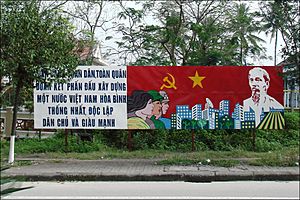
Party Relations with Other Countries
The CPV works to improve its relationships with other countries. As of 2010, the party had good relations with 222 political parties in 115 countries. This helps Vietnam's development. The party has relationships with both communist and non-communist parties, especially those important for Vietnam's economy.
Relations with other communist parties are very important. They are based on friendship and support for socialism. The CPV shares ideas with these parties about building socialism and party organization. The CPV takes part in international meetings of communist parties.
The CPV has strong ties with the Lao People's Revolutionary Party and the Cambodian People's Party. This is because all three parties came from the same original Indochinese Communist Party. It also has good relations with the Chinese Communist Party, the Communist Party of Cuba, and the Workers' Party of Korea. The CPV also has friendly relations with left-wing parties in Latin America.
Election Results
National Assembly Elections
| Election | Votes | % | Seats | +/– | Position | Outcome |
|---|---|---|---|---|---|---|
| 1960 | As part of the Vietnamese Fatherland Front |
421 / 421
|
Sole legal party | |||
| 1964 |
366 / 366
|
Sole legal party | ||||
| 1971 |
420 / 420
|
Sole legal party | ||||
| 1975 |
424 / 424
|
Sole legal party | ||||
| 1976 |
492 / 492
|
Sole legal party | ||||
| 1981 |
496 / 496
|
Sole legal party | ||||
| 1987 |
496 / 496
|
Sole legal party | ||||
| 1992 |
395 / 395
|
Sole legal party | ||||
| 1997 |
384 / 450
|
Sole legal party | ||||
| 2002 |
447 / 498
|
Sole legal party | ||||
| 2007 |
450 / 493
|
Sole legal party | ||||
| 2011 |
454 / 500
|
Sole legal party | ||||
| 2016 |
473 / 494
|
Sole legal party | ||||
| 2021 |
485 / 499
|
Sole legal party | ||||
See also
 In Spanish: Partido Comunista de Vietnam para niños
In Spanish: Partido Comunista de Vietnam para niños
- Human rights in Vietnam
- Politics of Vietnam
- National Assembly (Vietnam)


